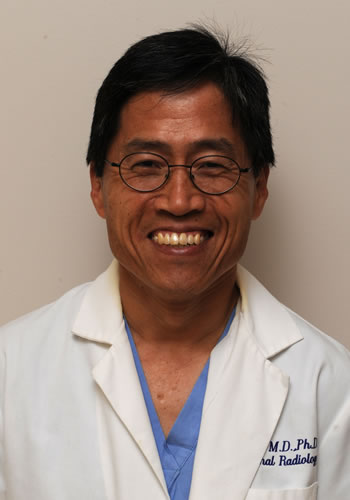Performing MRI vs. CT Scan
Dr. Hyo-Chun Yoon
Radiologist at Kaiser Permanente Hawaii
Where did you receive your schooling/training?
I attended Punahou and then Harvard University. I earned my medical degree and Ph.D. at UCLA, where I also did my radiology and interventional radiology training.
How long have you been practicing?
Since 1993.
Danielle Stettnisch
What do CT scans and MRI have in common?
They’re both three-dimensional imaging techniques, as opposed to plain X-rays, which are two-dimensional. They’re also multi-planar, so you can see them in all different kinds of imaging planes. With both CT and MRI images, we can get a three-dimensional view of the human body.
How do CT and MRI differ?
With CT we are looking at differences in the electron density of different body parts, whereas with an MRI we’re looking at the environment and the body’s overall number of hydrogen protons. The advantage of an MRI is that it enables us to better see intricate, small soft tissue differences, and we have a lot more variables to play with. The downside of the MRI is that it takes a lot longer than CT to collect information.
There’s a lot of overlap depending on what we want to examine. With a knee, an MRI is better than a CT for easily viewing tears in the menisci. An MRI also is useful for looking for disease in the brain, neck and back, and scarring in the heart.
Typically, we conduct CT scans if you have a complex fracture, as follow up with patients with cancer, and when we’re looking for appendicitis or examining the bowel. The bowel is constantly moving, so if you do an MRI that takes three to five minutes to get a single set of images, you’re going to have a lot of motion blurring. CT takes four or five seconds to do the entire scan, so it’s much better for capturing definition.
We also use CT to conduct a virtual colonoscopy, where we inflate the colon with air and, similar to playing a video game, fly through the colon looking for polyps.
The latest advancement with CT is looking at coronary arteries for blockages. By doing CT on the right patients, we may prevent them from having to get cardiac catheterization.
How long does an MRI generally take?
A quick knee scan can take 20 minutes. If we do a heart exam, where we’re looking at cardiac motion and searching for scar tissue, it can take considerably longer, maybe an hour.
Does either method present radiation concerns?
There is no ionizing radiation with an MRI and no known long-term detrimental effects. CT, on the other hand, does have a fair amount of ionizing radiation. In one CT scan of the chest or abdomen, you’re getting roughly three times the average yearly radiation dose that you would have gotten from all of the other sources of radiation in your life – radon in the soil, sun exposure, etc. The makers of CT scanners are trying to reduce that.
But we don’t want this to discourage people from getting a scan when a physician feels it’s appropriate. The younger you are when you have CT scans, the more likely it is that there’s going to be some effect from it. For one CT scan there doesn’t need to be a long debate, but if you’ve had several in the last couple of years, you and your doctor should have a discussion about whether undergoing another is necessary.
We don’t want people not to get CT scans if they really need them. At the same time, we want them to know there is a small risk involved.
In other news, your radiology facility has been upgraded.
Yes, we recently opened two new interventional radiology rooms at Moanalua Medical Center. We do directed arterial chemotherapy for liver cancer patients, endovascular therapy for complications associated with hemodialysis, and we treat people who fracture their backs. One of our new rooms is optimized for patients with brain aneurysms to have their aneurysms coiled. We’re constantly looking to advance and improve the specialized care that we provide our patients.







